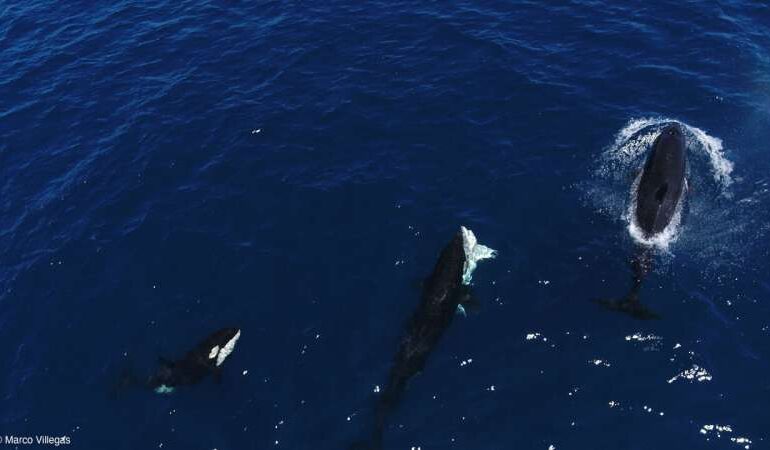Orcas Target Young Great White Sharks in Gulf of California

A specialized pod of orcas, known as Moctezuma’s pod, has been documented hunting and killing young great white sharks in the Gulf of California. This behavior marks a significant finding in marine biology, as the orcas are observed flipping these sharks upside down to access their nutrient-rich livers, a method that showcases their advanced hunting techniques.
The incidents were captured on camera during routine monitoring by marine biologists. In total, two separate hunts were recorded, resulting in the death of three juvenile white sharks. The first hunt took place in August 2020, where five orcas worked in unison to turn a juvenile shark upside down before consuming its liver. A similar pattern emerged in a second hunt in August 2022, where the orcas employed the same technique.
Advanced Hunting Techniques
Marine biologist Erick Higuera Rivas, the project director at Conexiones Terramar and Pelagic Life, emphasized the intelligence behind this hunting behavior. He stated, “Orcas that eat elasmobranchs—sharks and rays—could eat a great white shark if they wanted to.” This indicates that orcas may be more versatile predators than previously understood.
The technique of flipping a shark upside down induces a state known as tonic immobility, rendering the shark temporarily defenseless. Higuera explained, “This temporary state renders the shark defenseless, allowing the orcas to extract its nutrient-rich liver and likely consume other organs as well.” This behavior raises questions about the orcas’ hunting strategies and whether these techniques are passed down through generations.
According to Dr. Salvador Jorgensen from California State University, this is the first documented evidence of orcas specifically targeting juvenile great white sharks. Adult sharks tend to vacate their seasonal gathering areas in response to orca presence, while juveniles may not have the same instincts to evade their predators. “These juvenile white sharks may be naive to orcas,” Jorgensen noted, highlighting the vulnerability of younger sharks.
Environmental Changes and Implications
Changes in the distribution of great white sharks in the Pacific may provide new hunting opportunities for Moctezuma’s pod. Climate events, such as El Niño, appear to have altered shark nursery areas, increasing the presence of juvenile great whites in the Gulf of California. This environmental shift may expose these young sharks to increased predation risks.
The scientists plan to conduct a broader survey to gather more data on the dietary habits of this orca pod. Dr. Francesca Pancaldi from the Instituto Politécnico Nacional emphasized the importance of understanding these interactions for conservation efforts. “Generating information about the extraordinary feeding behavior of killer whales in this region will lead us to understand where their main critical habitats are,” she said.
While the findings are groundbreaking, researchers acknowledge the need for further investigation to determine whether these hunting patterns are consistent or if they fluctuate based on the availability of juvenile sharks. The unpredictability of orca hunts and the costs associated with fieldwork pose significant challenges for ongoing research.
The observations made by this research team contribute to a growing body of knowledge about orca behavior and their role as apex predators in marine ecosystems. As scientists continue to monitor these interactions, they aim to develop strategies to mitigate human impact on these vital habitats.
More information can be found in the study titled “Novel evidence of interaction between killer whales (Orcinus orca) and juvenile white sharks (Carcharodon carcharias) in the Gulf of California, Mexico,” published in Frontiers in Marine Science.






